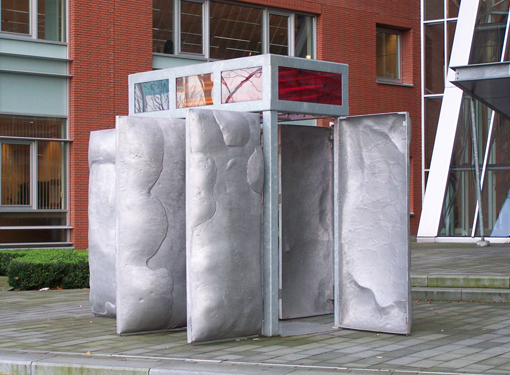Artist:
Sylvia Zijlmans, Hewald Jongenelis
Title:
Geen Titel
Year:
2004
Adress:
Graadt van Roggenweg, SVB
www.boijmans.nl:
Zijlmans en Jongenelis verbinden met ‘The Magnetic North & The Idea of Freedom’ lokale kwesties met grotere actuele thema’s als de beleving van individuele vrijheid en de vluchtelingenproblematiek. Daarmee maken ze het dagelijks leven in een buitenwijk van een uitdijende stad tot metafoor van de huidige tijd.
In de tentoonstelling was ook videokunst te zien van dit duo: The Idea of Freedom. Een man duwt een auto over een landweg. De deuren gaan voortdurend open en dicht terwijl er vuilnis uit de auto wordt gegooid. Langzaam verdwijnt deze uit beeld en laat een spoor van vuilnis achter: de vrijheid die velen nemen om alles er ongefilterd uit te gooien en binnen te dringen in andermans universum met ongevraagde, oninteressante en ongefundeerde zaken.
www.zijlmansjongenelis.nl:
Since Zijlmans and Jongenelis moved from the busy Jordaan neighbourhood to Amsterdam-North, their new environment found its way into their work in a natural way.
Their conversations with local residents highlighted several social issues. Concerns about changes to their neighbourhood, which is growing in popularity, turn out to be a recurring theme. In the course of lengthy discussions, they distilled images which position underlying personal thoughts and fears inside a larger actual, urgent and global context.
These universally recognisable issues have been translated into 8 performances, filmed on location in collaboration with the local community. Each of the videos features a mythical character, an ‘avatar’, whose presence spurs the people into action. This avatar, wearing an aluminum mask, personifies pressing concerns and hidden conflicts. Given names as the Evictor, the Bouncer and the Squanderer, and with themes as gentrification, appropriation of space and the struggle to find a parking place, the project reflects on themes found in the immediate environment.
At the same time it links these themes to greater themes as pollution, overpopulation, migration, the current refugee crisis and the experience of individual liberty. The red and black ink drawings, that cover all cabins and structures in the exhibition, are based on the drawings in notebooks that Zijlmans and Jongenelis kept during the talks and discussions.
Zijlmans en Jongenelis verbinden met ‘The Magnetic North & The Idea of Freedom’ lokale kwesties met grotere actuele thema’s als de beleving van individuele vrijheid en de vluchtelingenproblematiek. Daarmee maken ze het dagelijks leven in een buitenwijk van een uitdijende stad tot metafoor van de huidige tijd.
In de tentoonstelling was ook videokunst te zien van dit duo: The Idea of Freedom. Een man duwt een auto over een landweg. De deuren gaan voortdurend open en dicht terwijl er vuilnis uit de auto wordt gegooid. Langzaam verdwijnt deze uit beeld en laat een spoor van vuilnis achter: de vrijheid die velen nemen om alles er ongefilterd uit te gooien en binnen te dringen in andermans universum met ongevraagde, oninteressante en ongefundeerde zaken.
www.zijlmansjongenelis.nl:
Since Zijlmans and Jongenelis moved from the busy Jordaan neighbourhood to Amsterdam-North, their new environment found its way into their work in a natural way.
Their conversations with local residents highlighted several social issues. Concerns about changes to their neighbourhood, which is growing in popularity, turn out to be a recurring theme. In the course of lengthy discussions, they distilled images which position underlying personal thoughts and fears inside a larger actual, urgent and global context.
These universally recognisable issues have been translated into 8 performances, filmed on location in collaboration with the local community. Each of the videos features a mythical character, an ‘avatar’, whose presence spurs the people into action. This avatar, wearing an aluminum mask, personifies pressing concerns and hidden conflicts. Given names as the Evictor, the Bouncer and the Squanderer, and with themes as gentrification, appropriation of space and the struggle to find a parking place, the project reflects on themes found in the immediate environment.
At the same time it links these themes to greater themes as pollution, overpopulation, migration, the current refugee crisis and the experience of individual liberty. The red and black ink drawings, that cover all cabins and structures in the exhibition, are based on the drawings in notebooks that Zijlmans and Jongenelis kept during the talks and discussions.



